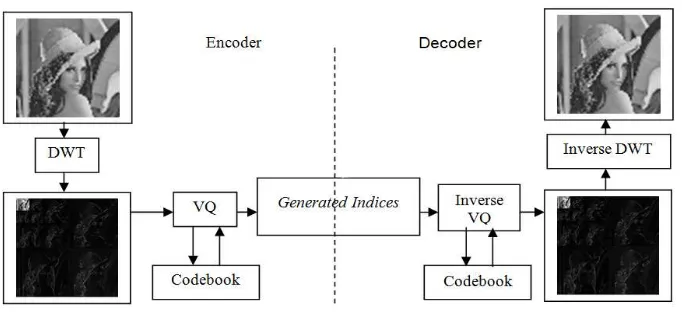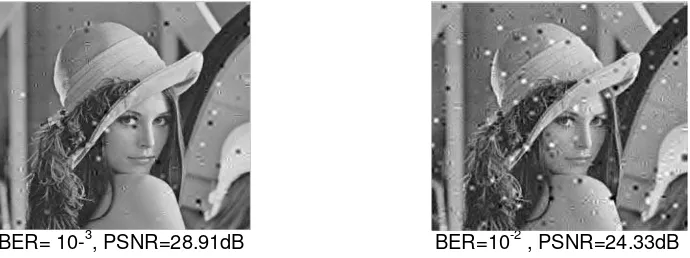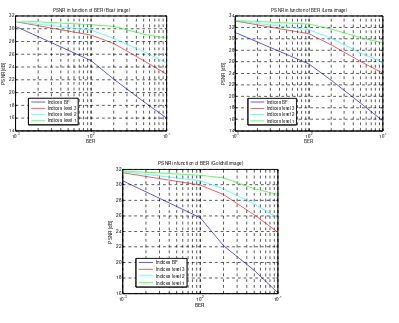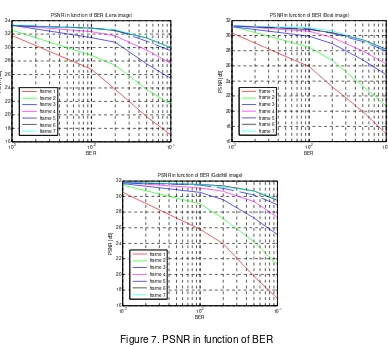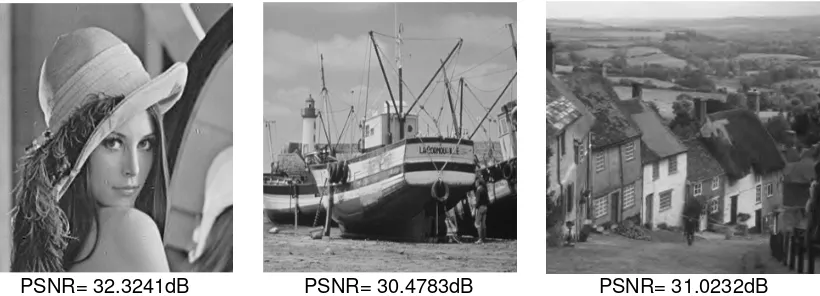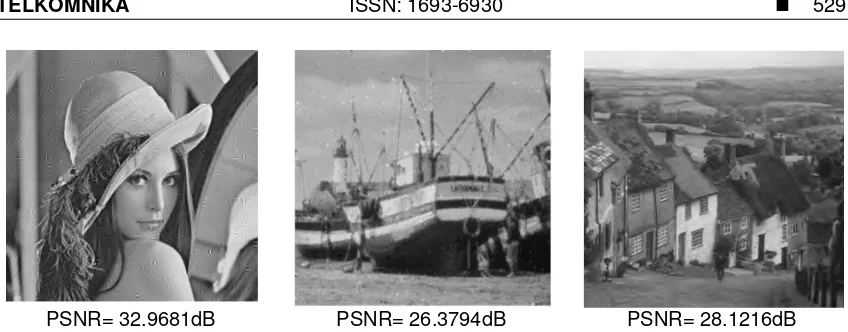DOI: 10.12928/TELKOMNIKA.v14i1.2947 523
Data Analysis for Image Transmitted using Discrete
Wavelet Transform and Vector Quantization
Compression
Mustapha Khelifi1*, A. Moulay lakhdar1, Iman Elawady2
1Department of Electrical Engineering, Tahri Mohammed University, Bechar, Algeria/ lab: TIT
2
Department of Electrical Engineering, Tahri Mohammed University,
Bechar, Algeria / lab: CAOSEE, BP 417 Route Kenadsa, Béchar 08000, Algeria, +213 49 23 89 93 *Corresponding author, e-mail: [email protected]
Abstract
In this paper we are going to study the effect of channel noise in image compressed with vector quantization and discrete wavelet transform. The objective of this study is to analyze and understand the way that the noise attack transmitted data by doing lot of tests like dividing the indices in different levels according to discrete wavelet transform and dividing each level in frames of bits. The collected information will helps us to propose solutions to make the received image more resistible to the channel noise also to benefit from the good representation obtained by using vector quantization and discrete wavelet transform.
Keywords: DWT, VQ, LBG, BSC channel, BER
Copyright © 2016 Universitas Ahmad Dahlan. All rights reserved.
1. Introduction
In recent years lot of research has been done to enhance the quality of received image after transmission in noisy channel, this problem can be solved using different techniques (source coding, channel coding , joint source channel coding or by optimize in restoration filters) as shown in articles [1-3].
A good representation and compression of image can make the difference on the quality of received image, also to understand how the channel noise attack the transmitted data can be provide an efficient techniques with less consumption in resource (processing unit, time, data size, …) and bandwidth usage.
In image compression, we know that, the combination between vector quantization and discrete wavelet transform provide a good representation of reconstructed image. Since the discrete wavelet transform analyze image and give us lot of data about 2D signal which make the difference in the quality of reconstructed image however In case of transmission the compression using VQ and DWT is so sensitive to the channel noise as shown in the articles [4-5].
To solve this problem we are going to analyze data during transmission to discover what is the most important parts that can make the difference in the quality or received image by doing lot of tests in transmitted indices according to the decomposed levels provided by discrete wavelet transform.
The paper is organized as follow: In the first part we will introduce the compression using vector quantization and discrete wavelet transform. The second part the effect of the channel noise in image compressed with vector quantization and discrete wavelet transform. In third part the effect of the channel noise in each level generated by discrete wavelet transform with different BER. In the fourth part we will divide each level to eight sublevels finally we try to propose some solutions according to the orbited results to that can enhance the quality of received image.
2. Compression Using DWT and Vector Quantization
quantization based image compression techniques is to match each input vector with a vector in the codebook so that the distortion between the input vector and the chosen code-vector is minimum [7] by evaluating the Euclidean distance between the input code-vector and each codeword in the codebook [8] . Once the closest codeword is found, the index of that codeword is sent through a channel .When the encoder receives the index of the codeword, it replaces the index with the associated [9]. Quantization is an irreversible process. That is, in general, there is no way to find the original value from the quantized value [10]. The difference between the input and output signals of the quantizer becomes the quantizing error, or quantizing noise [11].
The Discrete Wavelet Transform provides sufficient information both for analysis and synthesis of the original signal, with a significant reduction in the computation time [12].
Discrete Wavelet Transform (DWT) is used in a variety of signal processing applications, such as video compression, Internet communications compression, object recognition, and numerical analysis. It can efficiently represent some signals, especially ones that have localized change [13]
The steps compression using DWT and VQ as shown in Figure 1 are: 1) Decompose the image using the DWT transform to 3 levels.
2) Partition obtained bands into 4x4 blocks then apply Vector Quantization on each block and result is the compressed image.
Figure 1. Image compression steps using DWT and VQ.
This system got high compression ratio without loss of much information because applying DWT transform we minimize the domain of codebook vector. This will helpful in achieving high compression ratio without loss of information [14].
3. Transmission Channel
In this section, it is explained the results of research and at the same time is given the comprehensive discussion. Results can be presented in figures, graphs, tables and others that make the reader understand easily [2, 5]. The discussion can be made in several sub-chapters.
The binary symmetric channel (BSC) is defined by the channel diagram shown in Figure 2, and its channel matrix is given by Equation (1):
(1)
The channel has two inputs (x1 = 0, x2 = 1) and two outputs (y1 = 0, y2 = 1). The channel is symmetric because the probability of receiving a 1 if a 0 is sent is the same as the probability of receiving a 0 if a 1 is sent. This common transition probability is denoted by p [15]. The error events are also independent of the data bits [16]. This is the simplest model of a channel with errors, yet it captures most of the complexity of the general problem [17]. The
(2)
With the binary entropy function given by Equation (3):
(3)
Figure 2. Binary symmetric channel
4. The Effect of Error in Image Compressed with DWT+QV
In this part we are going to see how the noise attacks the image after transmission we will take an example of Lena image size 512x512, the block size is 4x4. The codebook is generated by LBG algorithm, with different BER (10-3, 10-2) as shown in Figure 3.
BER= 10-3, PSNR=28.91dB BER=10-2 , PSNR=24.33dB Figure 3. Received image using DWT and VQ compression with different BER
For transmission with the same parameters but with image compressed by VQ the simulation, results are represented as shown in Figure 4.
BER= 10-3, PSNR=28.30dB BER= 10-2, PSNR= 25.59dB Figure 4. Received image compressed by VQ with different BER
use channel
bit in 1 H(p) C
From the simulation results the quality of received image using VQ is better than the received one using DWT and VQ. However the PSNR of reconstructed image using DWT and QV (PSNR=33.35dB) is better than the reconstructed one using VQ (PSNR=30,67dB). Its look like we can not benefit from this enhancement during the transmission and this is what we are going to investigate it in the next parts.
5. The Effect of Error in the Levels of Image Compressed with DWT and VQ
Figure 5. Flowchart to study the noise effects on the indices in levels
10-3 10-2 10-1
PSNR in function of BER (Boat image)
Indices BF
PSNR in function of BER (Lena image)
Indices BF
PSNR in function of BER (Goldhill image)
We are going to divide the indices of vector quantization according to the levels of discrete wavelet transform (BF index, index level 3, index level 2, index level 1) each time we are going to test the effect of the noise in a matrix of bits and its indices, then calculates the PSNR of the degraded image, as shown in Figure 5.
For the simulation results we use two images (Lena, Boat,Goldhill), each index is represented by 8 bits with different BER (0.001, 0.01, 0.02, 0.05, 0.1), as shown in Figure 6. The simulation results show that the most sensitive levels are: level 3 and BF level compared with other levels
6. The Effect of the Channel Noise in the Frames of bits
In this part we are going to divide the bits of indices in 8 frames of bits. Each frame is constructed by bits of indices with the same weight. We test the effect of noise in one frame each time then we calculate the PSNR of received image with different BER (0.001, 0.01, 0.02, 0.05, 0.1), as shown in Figure 7.
Figure 7. PSNR in function of BER
7. The Application of Unequal Error Protection in Levels
To test the rightness of our study and collected information we use unequal error protection as application to our data. The main steps are as shown in Figure 8.
10-3 10-2 10-1
PSNR in function of BER (Lena image)
frame 1
PSNR in function of BER (Boat image)
frame 1
PSNR in function of BER (Goldhill image)
Figure 8. unequal error protection Flowchart (UEP)
For the simulation we use three images (Lena, Boat, Goldhill ) size 512x512 with different BER and codebook generated by LBG the results are shown in Figures 9, 10 and 11.
PSNR= 33.3533dB PSNR= 31.3346dB PSNR= 31.8231dB
Figure 9. Recived images with BER=10-3
PSNR= 32.3241dB PSNR= 30.4783dB PSNR= 31.0232dB
PSNR= 32.9681dB PSNR= 26.3794dB PSNR= 28.1216dB
Figure 11. Recived images with BER=0.05
We simulate the transmission channel of image using DWT and VQ for compression, which produce indices. We decompose the indices according to the levels each indices is coded in 8 bits. All matrices of bits of those indices are coded using RS code.
The simulation results show the rightness of our data analyze. The use of UEP as a solution optimize in the use of redundant data from the less to the most important data.
Of course, the quality of received image is going to be low with high BER levels but it’s still better compared with the compression using VQ and UEP as shown in Table 1.
Table 1. The quality of received image using VQ compression and UEP.
PSNR BER (10-3) BER (10-2) BER (5x10-2)
Lena 30.1708 dB 29.0494 dB 24.9971dB
Boat 28.5913 dB 27.9619dB 24.3983dB
Goldhill 29.1297 dB 28.2048dB 24.5350dB
Compared with other research papers concerned in de-noising image [18-19], our contribution to analyze the data during transmission provides a good way to understand how the noise attack the data, also it tell us what is the most sensitive data which make the difference in the quality of the received image, this can help us to propose some techniques that can protect the important data by using channel coding or by sending additional data that can help us in restoration.
8. Conclusion
In this paper we study the effect of channel noise in image compressed by DWT and VQ this study show us the keys that can help us to enhance the quality of received image, also provide analysis of data and knowledge about how the noise channel effect on the image the benefits of this study is concentrated about how to select a data that can make a difference in the quality of received image our suggestion to enhance the quality of image by using bit corrector for sensitive part of data.
Lot of flowcharts can be proposing to protect the important data in image. The proposed one is not the best as we guess, also it is applied just in levels so as future work may be we can design some flowcharts using UEP applied in levels and the frame of bits which can give us a good results.
References
[1] Mohsen Nasri, Abdelhamid Helali, Halim Sghaier, Hassen Maaref. Efficient JPEG 2000 Image
Compression Scheme for Multihop Wireless Networks. TELKOMNIKA Telecommunication
[2] Ali M Fadhil, Haider M AlSabbagh. Performance Analysis for Bit-Error-Rate of DS-CDMA Sensor
Network Systems with Source Coding. TELKOMNIKA Telecommunication Computing Electronics
and Control. 2012; 10(1): 165-170.
[3] Lydia Sari, Antonius Aditya. Raptor Code for Energy-Efficient Wireless Body Area Network Data
Transmission. TELKOMNIKA Telecommunication Computing Electronics and Control. 2015; 13(1):
277-283.
[4] Debnath JK, Rahim NMS, Wai-Keung Fung. A modified Vector Quantization based image
compression technique using wavelet transform. IEEE International Joint Conference on Neural Networks. 2008: 171-176.
[5] Binit Amin, Patel Amrutbhai. Vector Quantization based Lossy Image Compression using Wavelets –
A Review. International Journal of Innovative Research in Science, Engineering and Technology.
2014; 3(3): 10517-10523.
[6] H Malepati. Digital Media Processing DSP Algorithms Using C. 1st Edition. Newnes. 2010: 586. [7] Ajol Kumar Ray, Tinku Acharya. Information Technology Principles and Applications. Prentic Hall of
India. 2004.
[8] KV Kale, SC Mehrotra. Computer Vision and Information Technology: Advances and Applications. 2010; 50.
[9] Ryszard S Choras. Image Processing and Communications Challenges. Springer Science & Business Media. 2013: 236-238.
[10] Yun Q Shi, Huifang Sun. Image and Video Compression for Multimedia Engineering. Second Edition. CRC Press. 2008.
[11] Zhou Wang, Alan C Bovik. Mean squared error love it or leave it. IEEE signal processing magazine.
2009: 99-117.
[12] Valentina Zharkova. Artificial Intelligence in Recognition and Classification of Astrophysical and Medical Images (Studies in Computational Intelligence). Springer. 2007: 343.
[13] Michael Weeks. Digital Signal Processing Using MATLAB & Wavelets. Seconf Edition. Jones & Bartlett Learning. 2010: 271.
[14] Tejas S Patel, Ravindra Modi, Keyur J Patel. Image Compression Using DWT and Vector
Quantization. International Journal of Innovative Research in Computer and Communication
Engineering. 2013; 1(3): 653.
[15] Hwei P Hsu. Analog and Digital Communications (Schaum's Outlines). Second Edition. McGraw-Hill Education. 2002.
[16] Milan Sonka, Vaclav Hlavac, Roger Boyle. Image Processing Analysis and Machine Vision. Third
Edition. THOMSON, CL Engineering. 2007.
[17] John Miano. Compressed Image File Formats. Addison Wesley. 1999.
[18] Yan Feng, Hua Lu, Xiliang Zeng. Image Restoration Based on Hybrid Ant Colony Algorithm. TELKOMNIKA Telecommunication Computing Electronics and Control. 2015; 13(4): 1298-1304. [19] Jian Ren, Hua Lu, Xiliang Zeng. Image Denoising Based on K-means Singular Value Decomposition.
